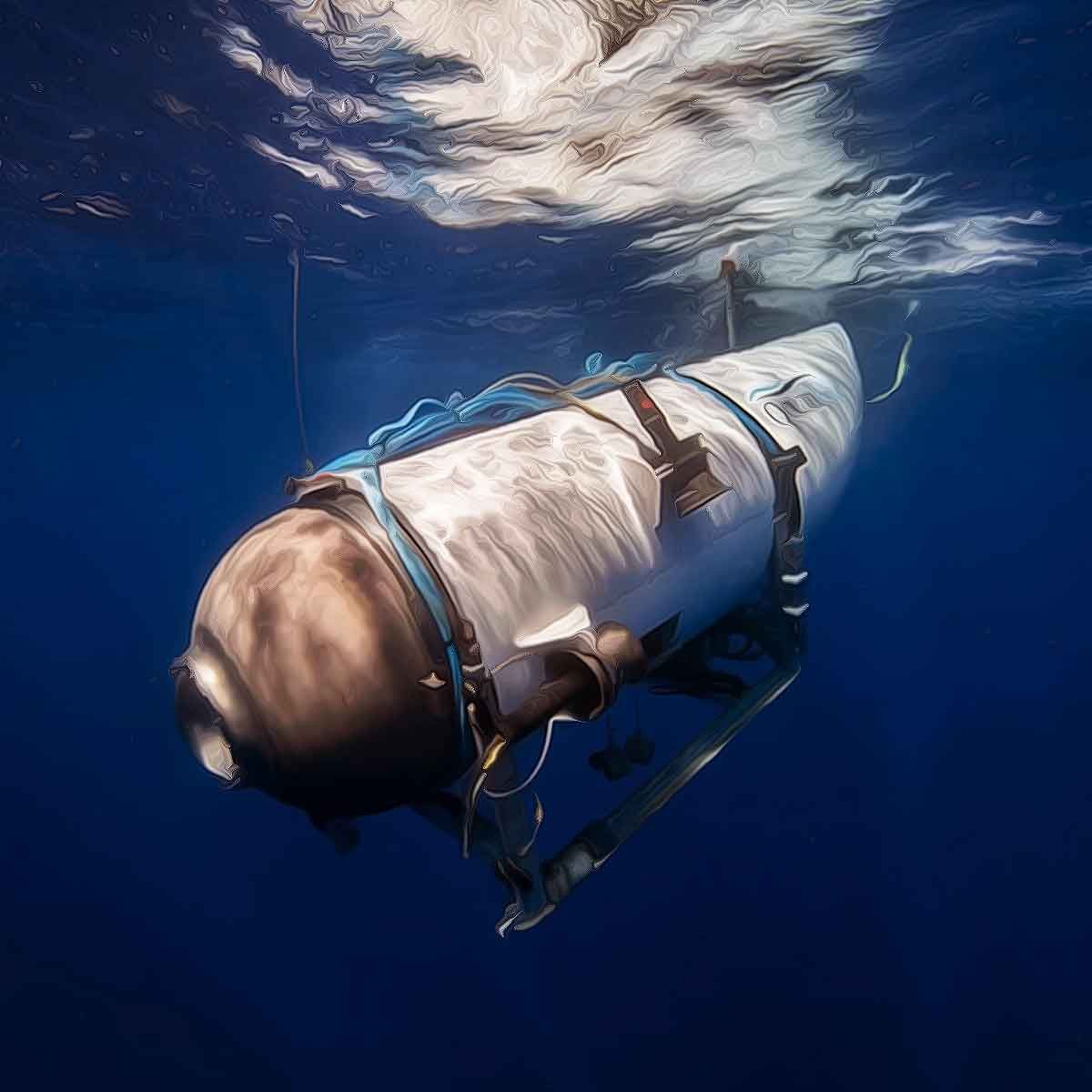MORE COVERAGE
Twitter Coverage
Satyaagrah
Written on
Satyaagrah
Written on
Satyaagrah
Written on
Satyaagrah
Written on
Satyaagrah
Written on
JOIN SATYAAGRAH SOCIAL MEDIA
"Titanic was called the Ship of Dreams, and it was. It really was": Deep-Sea Tragedy: The Catastrophic Implosion of Titan Submersible and the Lives Lost, it was on a mission to explore the Titanic, a ship that itself met a tragic end on its maiden voyage

On June 22, 2023, a tragic event unfolded in the depths of the North Atlantic Ocean. The Titan, a submersible operated by the US-based OceanGate Expeditions, was found in pieces due to a catastrophic implosion. This unfortunate incident resulted in the loss of five lives, marking a somber day in the history of deep-sea exploration. This article aims to provide an in-depth account of the incident, the people involved, and the aftermath.
|
The Titan was on a mission to explore the century-old wreckage of the Titanic, a ship that itself met a tragic end on its maiden voyage in April 1912. The submersible had been missing since June 18, when it lost contact with the surface support ship about 1 hour and 45 minutes into what was supposed to be a two-hour dive.
The search for the missing submersible ended five days later when a robotic diving vehicle, deployed from a Canadian ship, discovered a debris field of The Titan on the seabed. The debris was found approximately 1,600 feet from the bow of the Titanic’s wreckage, about 4 km beneath the surface level. The US Coast Guard Rear Admiral John Mauger confirmed the findings, stating, “The debris field here is consistent with a catastrophic implosion of the vehicle.”
The Titan had disintegrated into five major fragments, including the vessel’s tail cone and two sections of the pressure hull. However, the officials did not mention sighting human remains along with the debris. The catastrophic implosion of the Titan submersible was a shocking event that left the deep-sea exploration community and the world at large in a state of disbelief.
|
Onboard the vessel were five individuals, each with a unique story and a shared passion for exploring the world's oceans. The passengers included the company’s founder and CEO Stockton Rush, who was also piloting the vessel. The other four passengers were British billionaire Hamish Harding, French oceanographer and expert on the Titanic Paul-Henri Nargeolet, and Pakistani businessman Shahzada Dawood and his 19-year-old son Suleman.
OceanGate Expeditions confirmed the deaths of all five passengers onboard the vessel. The company expressed its sorrow, stating, “These men were true explorers who shared a distinct spirit of adventure, and a deep passion for exploring and protecting the world’s oceans.” It added, “Our hearts are with these five souls and every member of their families during this tragic time.”
The incident drew reactions from various quarters, including renowned filmmaker and deep-sea explorer James Cameron. Cameron, who directed the movie Titanic and has a deep interest in deep-sea exploration, expressed his shock and concern over the incident. He drew parallels between the Titanic disaster and the Titan's implosion, noting that both incidents involved warnings that went unheeded.
|
The Titan's implosion has raised questions about the safety protocols associated with deep-sea exploration. The incident has highlighted the need for stringent safety measures and the importance of heeding warnings and advice from experts in the field.
The Titanic, which sank after hitting an iceberg, claimed about 1,500 lives. The discovery of its wreckage in 1985 has since inspired many diving enthusiasts, including Cameron. The recent incident involving the Titan submersible, however, serves as a stark reminder of the risks associated with deep-sea exploration.
As investigations continue, the deep-sea exploration community and the world at large mourn the loss of the five individuals onboard the Titan. Their passion for exploring and protecting the world's oceans will not be forgotten. As we delve deeper into the mysteries of the deep sea, their tragic end serves as a reminder of the inherentrisks and the need for utmost caution in such endeavors.
The Titan submersible was a marvel of engineering, a 21-foot vessel capable of diving as far as 4,000 meters below sea level. It was designed to withstand immense pressure, up to 380 times the atmospheric pressure at sea level. However, the pressure at the depth of the Titanic wreckage, which sits 3,800 meters below sea level, is even more intense. This extreme environment is believed to have contributed to the catastrophic implosion of the Titan.
An implosion, as explained by oceanographer Bob Ballard, is when an object collapses in on itself in milliseconds due to crushing water pressure. The force delivered by such an implosion is immense and can result in fatal consequences, as was the case with the Titan.
|
This is not the first time a submersible has imploded under extreme pressure. In 2014, an unmanned submersible named Nereus suffered a similar fate while traveling at a depth of 9,990 meters in the Kermadec Trench northeast of New Zealand. In 1963, a U.S. nuclear submarine called Thresher imploded during a deep-sea dive 220 miles off Cape Cod, resulting in the death of all 129 sailors onboard.
The Titan's implosion and the loss of five lives have sent shockwaves through the deep-sea exploration community. The incident has sparked discussions about the safety protocols and standards associated with deep-sea exploration. As investigations continue, the focus is on learning from this tragic incident to prevent similar occurrences in the future.
|
The search for the Titan and its passengers was a massive international effort involving search planes and ships deployed to the northern Atlantic Ocean. Despite the tragic outcome, the untiring efforts of the search crews were a source of strength for the families of the victims during this difficult time.
The Dawood family, who lost Shahzada Dawood and his son Suleman in the incident, expressed their gratitude to the search crews. In a statement, they said, "Their untiring efforts were a source of strength for us during this time." Tributes poured in for the victims from around the world, with the White House and the Pakistani government offering their condolences to the families of the victims.
|
The aftermath of the Titan's implosion has been a time of mourning and reflection. As we remember the lives lost in this tragic incident, we are reminded of the inherent risks associated with deep-sea exploration. The incident serves as a stark reminder of the need for stringent safety measures and the importance of heeding expert advice in such endeavors.
As we continue to explore the mysteries of the deep sea, we do so with a renewed sense of caution and respect for the immense power of the ocean. The tragic end of the Titan and its passengers serves as a sobering reminder of the risks involved in deep-sea exploration, even as we strive to uncover the secrets of the ocean depths.
|
 Support Us
Support Us
Satyagraha was born from the heart of our land, with an undying aim to unveil the true essence of Bharat. It seeks to illuminate the hidden tales of our valiant freedom fighters and the rich chronicles that haven't yet sung their complete melody in the mainstream.
While platforms like NDTV and 'The Wire' effortlessly garner funds under the banner of safeguarding democracy, we at Satyagraha walk a different path. Our strength and resonance come from you. In this journey to weave a stronger Bharat, every little contribution amplifies our voice. Let's come together, contribute as you can, and champion the true spirit of our nation.
 |  |  |
| ICICI Bank of Satyaagrah | Razorpay Bank of Satyaagrah | PayPal Bank of Satyaagrah - For International Payments |
If all above doesn't work, then try the LINK below:
Please share the article on other platforms
DISCLAIMER: The author is solely responsible for the views expressed in this article. The author carries the responsibility for citing and/or licensing of images utilized within the text. The website also frequently uses non-commercial images for representational purposes only in line with the article. We are not responsible for the authenticity of such images. If some images have a copyright issue, we request the person/entity to contact us at This email address is being protected from spambots. You need JavaScript enabled to view it. and we will take the necessary actions to resolve the issue.
Related Articles
- "Tech Tycoon Tango": OpenAI, the brain behind ChatGPT, says 'game over' to CEO Sam Altman, Co-founder Greg Brockman follows suit, bidding adieu; board's 'confidence vote' seems more like a plot twist in a tech thriller. Who's scripting this, AI or humans?
- "Greatest crime since World War II has been US foreign policy": Ex-US General Wesley Clark explains how he was told by one General after 9/11 of how USA planned to take out 7 (Iraq, Syria, Lebanon, Lybia, Somalia, Sudan, and Iran) countries in 5 years
- "Entrepreneurship is the launching of surprises": Apple unveiled its long-awaited augmented reality (AR) headset, named the Vision Pro, as it sought to make its entry into a market currently dominated by Meta, the social media giant owned by Facebook
- India condemns Connecticut General Assembly for recognising declaration of Sikh Independence: 'Mischievous elements using Assembly for nefarious purposes, India and USA has no place for bigotry and hatred'
- EAM Jaishankar dismisses claims of institutional prejudice against minorities in India and critiques the UN, stating it 'lacks credibility and, to a large degree, effectiveness,' his US visit underscores India's pivotal role in reshaping global narratives
- Are We Alone in the Universe? NASA hints at the possibility of extra-terrestrial life, wants to establish New framework
- "Research is formalized curiosity. It is poking and prying with a purpose": Full-sized digital scan of the Titanic, which lies 3,800 m (12,500 ft) down in the Atlantic, has been created using deep-sea mapping, providing a unique 3D view of the entire ship
- "Things we can’t see affect our lives much more than we think": Money Heist - More than $200 billion may have been stolen from COVID-19 pandemic-relief programs, these Funds were meant for assisting small businesses hit by pandemic - federal watchdog
- Ten most compelling evidence of Extraterrestrial existence from 2020
- "Innovation is the calling card of the future": Jaldost, a revolutionary airboat by Bengaluru's National Aerospace Laboratories, powers through aquatic weeds, carving the path towards preserving cleaner water bodies, a testament to indigenous innovation
- Anti-virus software pioneer John McAfee hangs himself in a Spanish jail, old tweets spark conspiracy theories
- "Ability is Prabhu-given, prowess is earned": New Generation Ballistic Missile Agni Prime successfully flight tested by DRDO on 7th June from Dr APJ Abdul Kalam Island off the coast of Odisha, all the objectives of flight test successfully demonstrated
- “Monkeypox is demonstrating why smart people stay in monogamous relationships”: Defense Department spokesman Maj. Charlie Dietz announced the number of cases of monkeypox climbed tenfold in the U.S. military in less than four weeks ago
- In a tragedy that has shattered hearts globally, the young and bright Jaahnavi Kandula's life was unjustly taken, outrage boils as Officer Daniel Auderer displays an abominable lack of humanity, laughing and making vile remarks about her tragic death
- "Dekh raha hai na Binod, kitna mushkil pad raha hai Kamala ko batane main ki vo Kamala hai": Yes, VP of USA with utmost seriousness has to introduce like ‘I Am Kamala Harris. My Pronouns Are She and Her. I Am a Woman Sitting At Table Wearing a Blue Suit'

























